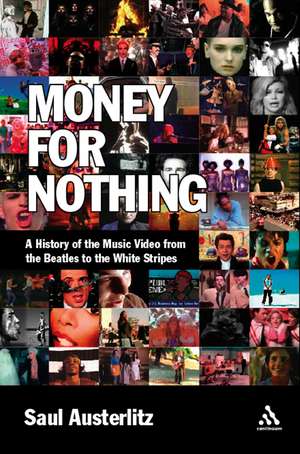Money for Nothing: A History of the Music Video from the Beatles to the White Stripes
Autor Saul Austerlitzen Limba Engleză Paperback – 14 mai 2008
Picture yourself in a darkened movie theater, or soothed by the pleasing glow of a television screen. You are watching as a history of the moving image unfolds onscreen, but this history will not take note of D.W. Griffith or Jean Renoir, nor will King Kong or Jaws make an appearance. As the images flicker past - of four ebullient Britishmen turning cartwheels in an open field, a man tap-dancing on an urban sidewalk, a wedding party in a rainstorm, a tragedy in a school classroom - they wax more familiar, the theme growing more coherent, more stable. They keep coming, though, quickly, relentlessly, constantly changing form, changing style, shapeshifting. The parade of images appears to possess a logic of its own, a guiding hand to steer its ship. Finally, as the last picture fills the screen - it happens to be of a shooting on a Brooklyn street - a light bulb goes off: these are all images from music videos, the short films that once ruled the airwaves, and still possess a significant hold on the generations raised by MTV. "I wonder what those were all about," you say...
The music video is a medium that appears to have run its course, or at least hit a substantial rut in its evolution. MTV and VH1 have morphed into lifestyle channels, the musical component of their programming reduced to a mere blip on their schedule. BET, CMT, and other music channels still maintain their dedication to showing music videos regularly, but their narrower audiences render them distinctly niche channels. And yet the video's shining moment as part disposable crap, part momentary, fleeting genius (the exact cinematic/televisual equivalent of the pop song, of course) renders it a subject worthy of some serious attention. Saul Austerlitz's fascinating book tells the history of the music video, delving into its origins, function, stars, motifs, genres, conventions, and masterpieces.
Austerlitz sees the music video as a fascinating oddity, capable of packing great wit, emotion, and insight into its brief span. A compelling marker of cultural history, the video emerged onto television screens nationwide and shone gloriously for a brief moment before disappearing into the remembrance of television past. Informed, opinionated, and always entertaining, Money for Nothing goes a long way toward retrieving the memory of this fleeting, evanescent art-form.
Preț: 215.22 lei
Preț vechi: 333.11 lei
-35% Nou
Puncte Express: 323
Preț estimativ în valută:
41.19€ • 44.72$ • 34.60£
41.19€ • 44.72$ • 34.60£
Carte tipărită la comandă
Livrare economică 22 aprilie-06 mai
Preluare comenzi: 021 569.72.76
Specificații
ISBN-13: 9780826429582
ISBN-10: 0826429580
Pagini: 268
Dimensiuni: 138 x 216 x 20 mm
Greutate: 0.37 kg
Editura: Bloomsbury Publishing
Colecția Continuum
Locul publicării:New York, United States
ISBN-10: 0826429580
Pagini: 268
Dimensiuni: 138 x 216 x 20 mm
Greutate: 0.37 kg
Editura: Bloomsbury Publishing
Colecția Continuum
Locul publicării:New York, United States
Caracteristici
This is the first full history and survey of the pop music video, from pre-MTV days right up to the present, when videos are still made, but increasingly watched on-line
Cuprins
Foreword and Acknowledgements
Introduction
Introduction
1. The pre-MTV years: Music Video in Fugue
2. The early years: Television Vaudeville
3. 1987-1991: This Video's For You
4. 1992-1997: Video Follies
5. Visions of a Youth Culture
6. Spike and Michel
7. Post MTV: No More Stars
Afterword
Appendix: The Top 100 Music Videos of All Time
Recenzii
'Money captures music video at an important turning point. As the Internet becomes our primary outlet for video viewing, we need writers like Saul Austerlitz - music fanatics who've watched more episodes of 120 Minutes than clinically recommended - to remind us of the medium's bygone halcyon era.'
"..Money for Nothing scans the development of the music video form, from its early 20th century roots in musical shorts shown before feature films, through the birth of the modern music-video era with 1981 launch of MTV... Austerlitz analyzes hundreds of videos, from Run DMC and Aerosmith's "Walk this Way" and Sinead O Connor's " Nothing Compares 2 U" to Weezer's "Buddy Holly" and Eminem's "Mosh", showing how each one responds to its era's trends and clichés... In the end, this is a book of music videos, one of the sweetest, fun-to-consume confections pop culture has to offer-and what's not to like about that?"-, Playboy.com, December 21, 2006.
'His [Saul Austerlitz] love-hate relationship with his subject...results in a study that's as informative...as it is entertaining. Four stars' ~ Mojo, March 2007
'Music videos finally get their proper due as a legitimate art form for rigorous analysis...Austerlitz is nothing if not thorough. He opens the book with an introduction that does a nice job of explaining just what this mutant media object connotes to the masses.' Marc Weingarten, Paste, Issue 28
"Praise is due Austerlitz for his diligence, open-mindedness and patience; watching as many videos as he has would have fried most others' brains.A New York critic who specializes in film and music, Austerlitz writes for publications mainstream, specialist and what started out alternative, like Spin. 'Money for Nothing,' his first book, is a niche product. Its primary appeal will be to other critics; if its marketed effectively, it should also appeal to music, video and film fans, and those eager to break into those businesses...Austerlitz is a gifted critic; he's particularly OK in my book because he, too, can't stand Creed front man Scott Stapp or Limp Bizkit's Fred Durst. Austerlitz likes the genre once known as alternative rock, shuns heavy metal and 'nu metal,' disses many hip-hop videos (for reasons similar to his dislike of heavy metal videos), considers Eminem subversive and powerfully political, and proffers kind words not only about music videos auteurs like Spike Jonze and Michael Gondry (his faves) but also about various musical groups. When band and video come together well, his interpretation can be dense, warm and illuminating..." Carlo Wolff, SFGate.com, March 18, 2007
"It's about time someone wrote a comprehensive tome to the music video. From the very early days of music shorts to You Tube, Brooklyn-based music critic Saul Austerlitz has a lot to talk about...this in-depth analysis of hundreds of videos is done in an interesting way that will teach you tons about bands, MTV and the 80's. If you only read a few pages, check out the author's list of his top 100 videos."- Chart, April 2007
-Mention. Publishers Weekly/ January 15, 2007
"...Austerlitz does a nice job of documenting how the cleverest video directors have boosted their credibility by paying homage to cinematic landmark; he knows how to connect Sinead O'Connor to Maria Falconetti's silent-era Joan of Arc. And "Money for Nothing" shows just how much Hollywood has, in turn, been influenced by MTV."- James Sullivan, The Boston Globe, June 18, 2007
"..Money for Nothing scans the development of the music video form, from its early 20th century roots in musical shorts shown before feature films, through the birth of the modern music-video era with 1981 launch of MTV... Austerlitz analyzes hundreds of videos, from Run DMC and Aerosmith's "Walk this Way" and Sinead O Connor's " Nothing Compares 2 U" to Weezer's "Buddy Holly" and Eminem's "Mosh", showing how each one responds to its era's trends and clichés... In the end, this is a book of music videos, one of the sweetest, fun-to-consume confections pop culture has to offer-and what's not to like about that?"-, Playboy.com, December 21, 2006.
'His [Saul Austerlitz] love-hate relationship with his subject...results in a study that's as informative...as it is entertaining. Four stars' ~ Mojo, March 2007
'Music videos finally get their proper due as a legitimate art form for rigorous analysis...Austerlitz is nothing if not thorough. He opens the book with an introduction that does a nice job of explaining just what this mutant media object connotes to the masses.' Marc Weingarten, Paste, Issue 28
"Praise is due Austerlitz for his diligence, open-mindedness and patience; watching as many videos as he has would have fried most others' brains.A New York critic who specializes in film and music, Austerlitz writes for publications mainstream, specialist and what started out alternative, like Spin. 'Money for Nothing,' his first book, is a niche product. Its primary appeal will be to other critics; if its marketed effectively, it should also appeal to music, video and film fans, and those eager to break into those businesses...Austerlitz is a gifted critic; he's particularly OK in my book because he, too, can't stand Creed front man Scott Stapp or Limp Bizkit's Fred Durst. Austerlitz likes the genre once known as alternative rock, shuns heavy metal and 'nu metal,' disses many hip-hop videos (for reasons similar to his dislike of heavy metal videos), considers Eminem subversive and powerfully political, and proffers kind words not only about music videos auteurs like Spike Jonze and Michael Gondry (his faves) but also about various musical groups. When band and video come together well, his interpretation can be dense, warm and illuminating..." Carlo Wolff, SFGate.com, March 18, 2007
"It's about time someone wrote a comprehensive tome to the music video. From the very early days of music shorts to You Tube, Brooklyn-based music critic Saul Austerlitz has a lot to talk about...this in-depth analysis of hundreds of videos is done in an interesting way that will teach you tons about bands, MTV and the 80's. If you only read a few pages, check out the author's list of his top 100 videos."- Chart, April 2007
-Mention. Publishers Weekly/ January 15, 2007
"...Austerlitz does a nice job of documenting how the cleverest video directors have boosted their credibility by paying homage to cinematic landmark; he knows how to connect Sinead O'Connor to Maria Falconetti's silent-era Joan of Arc. And "Money for Nothing" shows just how much Hollywood has, in turn, been influenced by MTV."- James Sullivan, The Boston Globe, June 18, 2007
Descriere
Saul Austerlitz's fascinating book tells the history of the music video, delving into its origins, function, stars, motifs, genres, conventions, and masterpieces


















